Lombard–Gepid War (567)
| Lombard–Gepid War (567) | |||||
|---|---|---|---|---|---|
 Gepid kingdom (539–551) | |||||
| |||||
| Belligerents | |||||
| Lombards and Pannonian Avars |
Gepids Byzantine Empire | ||||
| Commanders and leaders | |||||
| Alboin |
Cunimund † Usdibad Baduarius | ||||
| Casualties and losses | |||||
| Significant | |||||
In 566, Lombard king Alboin concluded a treaty with the Pannonian Avars, to whom he promised the Gepids' land in case they won over them.[1] The Gepids were destroyed by the Avars and Lombards in 567.[1][2] Gepid king Cunimund was killed by Alboin himself.[1] The Avars now occupied "Gepidia", forming the Avar Khaganate.[1] The Byzantine Emperor intervened and took control of Sirmium (now Sremska Mitrovica, Serbia), also giving refuge to Gepid leader Usdibad, but the rest of Gepidia was taken by the Avars.[2] Gepid military strength was significantly reduced;[1] according to H. Schutz (2001) many of them joined Lombard ranks, while the rest took to Constantinople (the Byzantine Empire).[1] According to R. Collins (2010) the remnants were absorbed either by the Avars or Lombards.[2] Although later Lombard sources claim they had a central role in this war, it is clear from contemporary Byzantine sources that the Avars had the central role.[2] The Gepids disappeared and the Avars took their place as a Byzantine threat.[1] The Lombards disliked their new neighbours and decided to leave for Italy, forming the Kingdom of the Lombards.[1]
According to Lombard Benedictine scribe Paul the Deacon (720s–799), Cunimund's daughter Rosamund, who was taken hostage by the Lombards and taken by Alboin as his wife, suffered from his cruelty. He forced her to drink from the skull of her dead father (which he carried around his belt), inviting her "to drink merrily with her father".[3]
See also
- Battle of Asfeld (552)
References
Sources
- Collins, Roger (2010). Early Medieval Europe, 300-1000. Palgrave Macmillan. pp. 201–. ISBN 978-1-137-01428-3.
- Foulke, William Dudley (1907). History of the Lombards [Historia gentis Langobardorum]. Philadelphia.
- Schutz, Herbert (2001). Tools, Weapons and Ornaments: Germanic Material Culture in Pre-Carolingian Central Europe, 400-750. BRILL. pp. 81–. ISBN 90-04-12298-2.